DURING the next two weeks a series of two metre high “stained glass” panels telling the story of St Boniface will be installed at key locations around the town.
The Boniface Heritage Trail is a major community project led by Crediton’s Town Team and it has taken four years of hard work by local volunteers to create and fund.
It is hoped that the new trail will bring many inquisitive visitors to our High Street and publicise perhaps the town’s most significant historical person.
Town Team project manager Rod Brookes-Hocking, who has driven the project said: “ Up until last year, when Boniface was made patron Saint of Devon, he was probably better known in Germany, where he is a national apostle.
“He is also an apostle in the Netherlands where he was killed in 754, while in France he is known as the Englishman who crowned the first-ever King of France.
“In Italy, in the Vatican, many of his letters written between 700 and 754 are still readable, securely stored and studied each year. Famous for many years, even for centuries in other countries, his time has perhaps now come to become better known in the town he was born and brought up in”.
His story is being told in a sequence of eight panels which look like stained glass windows. They are stylised versions of eight actual stained glass windows in Crediton Parish Church.
These adaptations first saw light as hand-made nylon banners designed and made six years ago by local artist Charlotte Turner, who each year helps make the distinctive high street flags for the Town Team.
Her banners gave the Town Team the idea of morphing them into solid weatherproof heritage trail signs, ones which would lead people through the town and along the high street, partly as a visitors route but also as signs of respect for one of our famous ancestors.
As their project developed the team looked at many different locations in the town where eight signs might be placed. Some were too far off the beaten track, others were too close to the roads to comply with Highway regulations, others they simply couldn’t get landowner permission for, but gradually the eight locations began to firm up.
Mid Devon District Council was interested in hosting four of them on its land: St Lawrence Green, the Town Square, Newcombes Meadow and East Street junction and the Roman Catholic Church in Park Street offered theirs.
The Holy Cross (Parish Church) expressed interest, then so too did the Methodist and Congregational churches, all of them along the high street.
Meeting with all the different parties involved, listening to their concerns and revising the plans took 18 months.
More than 100 local people were involved. Meanwhile, the team applied to a European Funding source called LEADER, which in the UK was administered via Devon County Council.
Competitive quotes were required for each stage of production, from having the designs printed on special sheets of acetate in the Netherlands, having those acetates bonded within thick sheets of toughened laminated glass near Bristol, having eight steel support structures fabricated by local steel company Conibear Brothers of Crediton, and for getting the sites excavated and the signs installed by local builder RJ Brooks and Son, also from Crediton. Every three months all of the estimates had to be renewed, resulting each time with some companies dropping out and new ones needing to be found.
The first planning application to Mid-Devon was awarded in late 2018. A separately required planning application to the Church of England for the one in the grounds of the Grade One Parish Church took two years of deliberations before being granted. Planning conditions for all eight signs require archaeologists to examine each site while the footings are being dug out.
Now, with just two weeks to go before the European LEADER fund winds up its UK work, the team have finally received all of the necessary planning and funding and stakeholder permissions, so excavations and installations are underway.
The designs for the acetate sheets took local graphic designer Karl Triebel many weeks of voluntary work late into the nights to enhance the photos of Charlotte Turner’s hand-made banners.
The steel frames, which were designed free-of-charge by the now retired structural engineer Bill Badger, will be attached to horizontal steel beams anchored under the ground to make it look as though each panel rises from the ground without support.
Each sign also has a QR code embedded in the border of the design: For those with a smartphone a simple camera scan of each QR code will take them to eight separate web pages where more information can be seen. These web pages are in English, German, French and Dutch. The same pages can also be accessed at: www.creditontownteam.org.uk .
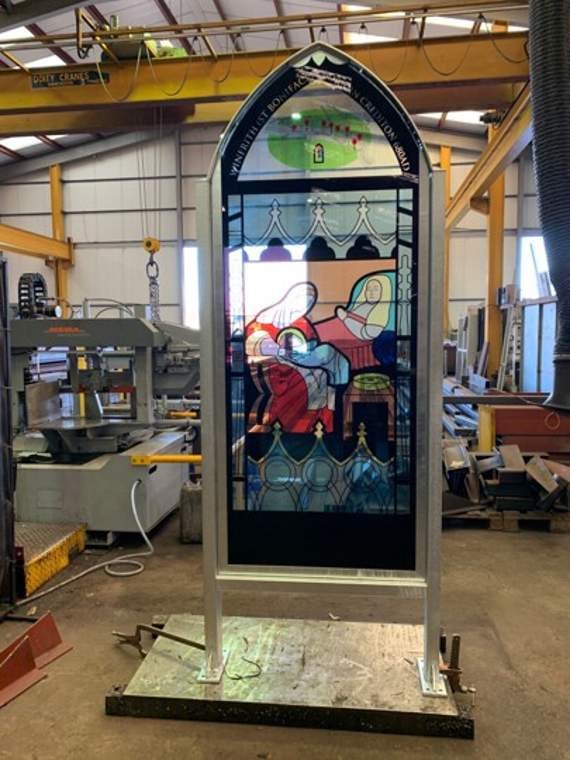
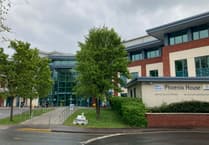
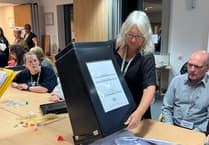
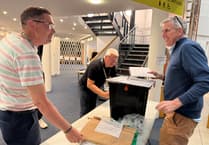
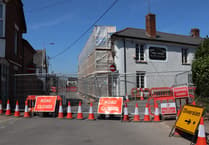
Comments
This article has no comments yet. Be the first to leave a comment.